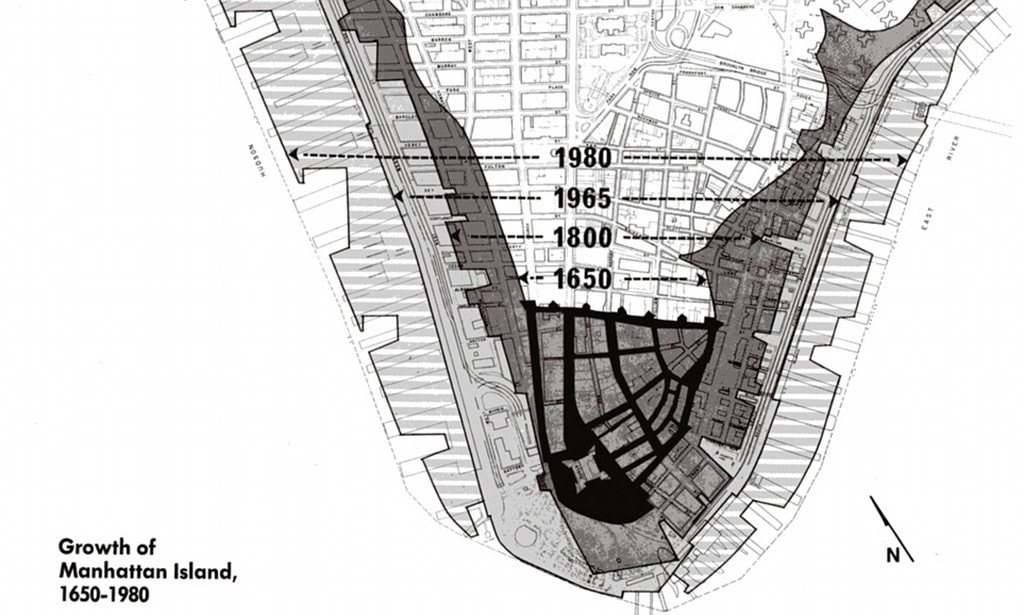|
By Laurie Lewis What can a growing city do when it wants more land to build on? For New York, the answer has always been to build on the water. The original Dutch colonists settled in the southern tip of Manhattan. Surrounded by water on three sides, the land mass of this part of the island was about a third as wide then as it is today. In the English colonial and early American periods, the eastern, southern, and western shores of Lower Manhattan pushed out into the rivers, filled in with garbage and building debris. During this period, piers for the busy shipping trade arose, and new real estate became available on water lots (areas that had been at least partially submerged). It was literally possible to walk where water had once been. The original Dutch settlement of Manhattan (1624-1664) is indicated by the darkest lines. Landfill expanded Manhattan for hundreds of years. An oft-repeated statistic is that 80 percent of New York’s trash has been dumped in the water. But garbage is just a small fraction of the landfill. A city that was constantly undertaking major construction projects in the nineteenth and twentieth centuries needed somewhere to dispose of excavated material and rubble from demolition of old buildings. Manhattan was not the only recipient of the landfill. Debris from construction of the subway system in the early twentieth century, for example, greatly expanded Ellis Island. Use of landfill to build along New York’s water boundaries was such a go-to solution that it addressed a problem in distant cities in the wake of World War II. The problem: what to do with rubble from bomb-devastated London and Bristol. American ships that brought supplies to England carted the rubble away as ballast on their return across the Atlantic. The imported landfill became the base for part of the FDR Drive along the East River. Material excavated in the 1960s for construction of the World Trade Center didn’t have to travel nearly as far. It was deposited along the Hudson shore of Lower Manhattan to create an entirely new community: Battery Park City. Nature sometimes dramatically reminds humans that tampering with it has consequences. In 2012, storm surges associated with Hurricane Sandy flooded areas that once had been under water. But this rare event probably won’t stop New York from reusing its refuse to create more land on the water that surrounds the city. Walking on Air Another way to create land on which to build is to take advantage of air rights over railroad tracks. The structures that rise above the tracks are essentially built on platforms or bridges firmly anchored into the bedrock. New York City has two stellar examples, one about a century old and the other brand new. Most people do not realize that they are walking or riding on a bridge when they are on Park Avenue north of Grand Central Terminal. Park Avenue is high above the railroad tracks going into and out of the train station. Upscale hotels for train travelers were the original buildings of Terminal City, as the area was dubbed. Office towers now dominate this busy stretch of Midtown. This year, a brand-new city-within-the-city opened on Manhattan’s West Side. Hudson Yards is a mixed-use collection of office towers, apartment buildings, parks, shops, and entertainment venues. The complex is built on platforms over a large rail yard, so visitors are literally walking on air. July Tours Most Take a Walk New York tours cover 1 to 2 miles, last 2 to 2½ hours, and cost $25 per person. Advance registration is required. To register and to learn the meeting place, email the guide ([email protected] or [email protected]). Please arrive a little before the start time. Tours are cancelled if nobody has registered or if the weather is extreme; if in doubt, call or text Laurie (917-306-2868) or Alan (917-363-4292). Mansions of Fifth Avenue You can still find magnificent mansions built about a hundred years ago on the Upper East Side. These freestanding and rowhouse mansions are interspersed among luxury apartment buildings—mansions in the sky. Hear about these palatial homes and the people who lived in them—New York City’s own rich and famous. Laurie offers this tour on Saturday, July 6, at 1 PM. To reserve a place on the tour and to learn the meeting location, email the guide at [email protected]. Greenwich Village: In the Footsteps of Writers Many writers and other creative people have called Greenwich Village home. On this tour, you’ll meander through charming Village streets and peek into hidden cul-de-sacs as you learn where some famous writers—including Edna St. Vincent Millay, e.e. cummings, and Edward Albee—lived. Maybe the Village aura will spark your own creativity! Laurie gives this tour on Sunday, July 14, at 1 PM. To reserve a place and to learn the meeting location, email her at [email protected]. Public Art of Lower Manhattan You don’t need to go to a museum to see great art. This interactive tour includes some of the most interesting and varied art in New York City. The artworks are as old as the doors of Trinity Church and as new as the SeaGlass Carousel. Alan gives this tour on Sunday, July 21, at 10 AM. Email him ([email protected]) to reserve your place and to learn the meeting location. Central Park: Marvels of the Northern Half The northern end of Central Park features some of the city’s most surprising landscapes. Take a hike in the woods, and you’ll feel as though you’ve left the city. Discover New York’s own Secret Garden. If history rather than nature is your thing, fear not. You’ll learn about the role this area played in early American wars. Join Alan on Wednesday, July 31, at 11 AM to explore the northern part of Central Park. To reserve a spot and to learn where to meet, email him at [email protected]. July Tours
|
Archives
April 2024
|


